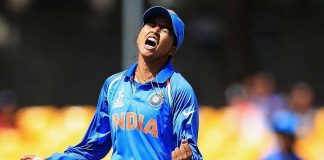FEBRUARY 5, 2020
Brief Scorecard: New Zealand 348 for 6 (Taylor 109*, Nicholls 78, Latham 69, Yadav 2-84) beat India 347 for 4 (Iyer 103, Rahul 88*, Kohli 51, Southee 2-85) by four wickets

HAMILTON, NEW ZEALAND – Naturalised wicketkeepers. Naturalised No. 5s. Tom Latham and KL Rahul played lovely impactful innings – 69 off 48 and 88* off 64 – after walking in in the 29th over of their respective innings, but Latham had a more fluent No. 4 he was supporting as New Zealand chased down 348 to end an eight-match losing streak in international cricket. Under pressure for his inability to get New Zealand over the line in the T20Is, one of the elite ODI batsmen in the world, Ross Taylor, played a blinder, 109 not out off 84 balls.
In another similarity between the two innings, India’s No. 4, Shreyas Iyer, too scored a maiden international hundred, but he was allowed to score at only a run a ball despite a late onslaught. Those middle overs when Iyer and Virat Kohli could add 102 in 20 overs might just have been the difference between the sides.
You might want to criticise a pitch as too batting-friendly if it allows 348 to be chased down with consummate ease, but there was a bit in it for the bowlers. In the afternoon, there was just enough nip for Colin de Grandhomme and James Neesham to bowl 16 overs for just 93 runs and pick up one wicket. One of those was to a teasing de Grandhomme delivery that debutant Prithvi Shaw nibbled at. There might be a bit of that in the Tests too. The other debutant, Mayank Agarwal, cut fiercely, but straight to point to make it 54 for 2.

India were playing two debutant openers because both Rohit Sharma and Shikhar Dhawan were missing, and they wanted Rahul to take on the new role seriously. In his first audition at that station – a forced one because of an injury to Rishabh Pant – Rahul became the first India batsman since 2013 to score 50 or more from No. 5 or below at a strike rate of more than 150 when batting first. It might sound like a convoluted statistic, but India have been missing that mix of power and consistency for a long time.
Before Rahul, though, there were Virat Kohli and Iyer. New Zealand’s stand-in captain, Latham, decided to delay the introduction of spin to utilise that period of slight nip even though data says you introduce legspin when Kohli is new at the crease. De Grandhomme and Neesham, though, kept India honest with Iyer in particular taking his time to get used to the movement. He scored 15 off the first 29 balls he faced, which included two spilled half-chances. In the same time, Kohli had sauntered to 25 off 34.
By the time Latham went to legspin, Kohli had made his way to an effortless fifty. Iyer’s runs at the other end were mainly through aerial hits for fours, which brought on cheers from Kohli but also carried risks. Be that as it may, both had momentum when Ish Sodhi was brought on. His fourth ball pitched on a length, on off, drawing a forward defensive from Kohli, who looked to open the face to perhaps look for a single with the spin. Except that this one spun the other way, just enough to hit his pad plumb in front before carrying on to dislodge a bail for good measure.
At 156 for 3 in the 29th over, if New Zealand thought they had a chance of coming back into the match, it wasn’t to be. Rahul had a sighter for 17 balls before unleashing with full force. Sodhi was chipped over long-off for a six before a googly next ball was smashed flat over long-on. Pretty soon, Tim Southee was getting the same dose of back-to-back sixes from Rahul. Iyer, still struggling for fluency, at 58 off 73, could use the opportunity to delay his slog. It came in due time, though, as he raced to a hundred off 101 balls. Along the way, de Grandhomme dropped him too.
Missing all three of their first-choice ODI quicks, New Zealand were now under the pump in the death overs. Rahul and Kedar Jadhav had all the fun at the end, but Hamish Bennett’s last three overs – six in the 45th, eight in the 47th and seven in the 50th – kept India to 347.
Cruel irony that it might be, teams set up to break such chases down to a 30-over innings and a T20 in the end. They want wickets in hand, and anything under 200 is chaseable these days. Naturalised opener Henry Nicholls played his part in keeping New Zealand in the chase by the time the final 20 began. He scored a busy 78 off 82, hitting 11 fours, stitching together a partnership of 85 with Martin Guptill and then 62 with Taylor.
Both these stands came at nearly a run a ball, which meant India were desperate for wickets around the 30-over mark. Kohli saw Mohammed Shami bowl a slower offcutter that found purchase. He also saw some swing. India went double barrel, and brought Jasprit Bumrah on. The runs slowed down, and Nicholls went for an opportunistic one only to be superbly run out by Kohli.
Bumrah troubled the new man Latham with the offcutter. He scored just three off the first 12 balls he faced. With 170 required off the last 19 overs and that much grip in the pitch, things looked difficult for New Zealand. Then Latham began to sweep Kuldeep Yadav. Taylor slogged Shardul Thakur. More sweeps. More slogs. Everything nailed. Not content with having slogged Bumrah for a six, Taylor then went on to damage Ravindra Jadeja’s figures with a slogged six and four in the 37th over. Sixty-two runs in six overs later, the required run rate was down to 6.75.
As a result, India were forced to bring Bumrah back sooner than they usually do, and even he was punched away for four past point by Latham. In the 40th over, Taylor went after Thakur with a vengeance, taking 22 runs and leaving themselves 56 to get.
Latham fell soon, triggering a mini collapse – and giving fans a reminder of the events of the T20I series – but Taylor and Mitchell Santner made sure there were no further hiccups. Perhaps it helped there was no option of a Super Over.
Courtesy/Source: ESPNCricinfo










































































































